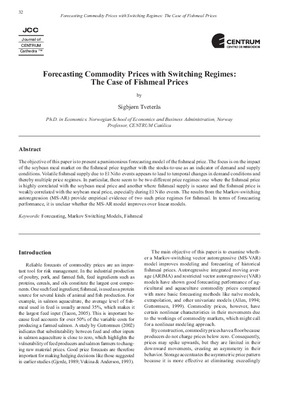| dc.contributor.author | Tveterås, Sigbjørn | |
| dc.date.accessioned | 2023-07-21T19:18:11Z | |
| dc.date.available | 2023-07-21T19:18:11Z | |
| dc.date.issued | 2010 | |
| dc.identifier.uri | https://repositorio.pucp.edu.pe/index/handle/123456789/194776 | |
| dc.description.abstract | The objective of this paper is to present a parsimonious forecasting model of the fishmeal price. The focus is on the impact of the soybean meal market on the fishmeal price together with the stocks-to-use as an indicator of demand and supply conditions. Volatile fishmeal supply due to El Niño events appears to lead to temporal changes in demand conditions and thereby multiple price regimes. In particular, there seem to be two different price regimes: one where the fishmeal price is highly correlated with the soybean meal price and another where fishmeal supply is scarce and the fishmeal price is weakly correlated with the soybean meal price, especially during El Niño events. The results from the Markov-switching autoregression (MS-AR) provide empirical evidence of two such price regimes for fishmeal. In terms of forecasting performance, it is unclear whether the MS-AR model improves over linear models. | en_US |
| dc.language.iso | eng | |
| dc.publisher | Pontificia Universidad Católica del Perú. CENTRUM | |
| dc.relation.ispartof | urn:issn:1851-6599 | |
| dc.rights | info:eu-repo/semantics/openAccess | es_ES |
| dc.rights.uri | http://creativecommons.org/licenses/by/4.0 | * |
| dc.source | Journal of CENTRUM Cathedra, Vol. 3, Issue 1 | |
| dc.subject | Fishmeal | en_US |
| dc.subject | Forecasting | en_US |
| dc.subject | Markov Switching Models | en_US |
| dc.title | Forecasting Commodity Prices with Switching Regimes: The Case of Fishmeal Prices | en_US |
| dc.type | info:eu-repo/semantics/article | |
| dc.type.other | Artículo | |
| dc.subject.ocde | https://purl.org/pe-repo/ocde/ford#5.02.04 | |
| dc.publisher.country | PE | |


